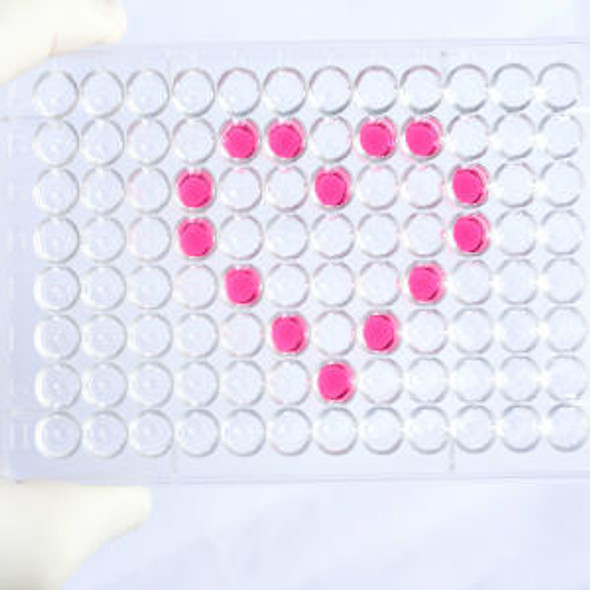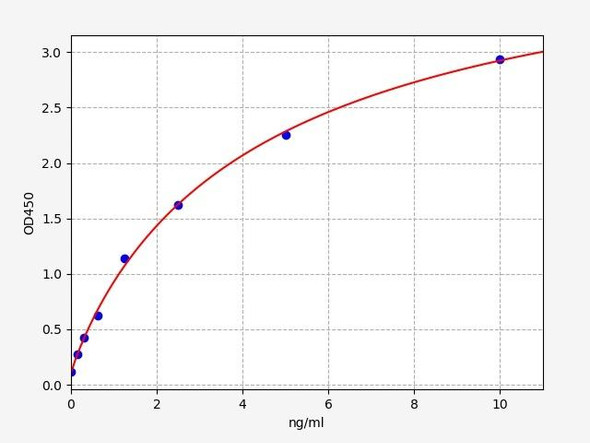Human Cell Biology ELISA Kits 2
Human TERT (Telomerase Reverse Transcriptase) ELISA Kit (HUES01857)
- SKU:
- HUES01857
- Product Type:
- ELISA Kit
- Size:
- 96 Assays
- Uniprot:
- O14746
- Sensitivity:
- 0.09ng/mL
- Range:
- 0.16-10ng/mL
- ELISA Type:
- Sandwich
- Synonyms:
- CMM9, DKCA2, DKCB4, EST2, PFBMFT1, TCS1, TP2, TRT
- Reactivity:
- Human
- Sample Type:
- Serum, plasma and other biological fluids
- Research Area:
- Cell Biology
Description
| Assay type: | Sandwich |
| Format: | 96T |
| Assay time: | 4.5h |
| Reactivity: | Human |
| Detection Method: | Colormetric |
| Detection Range: | 1.56-100 ng/mL |
| Sensitivity: | 0.94 ng/mL |
| Sample Volume Required Per Well: | 100µL |
| Sample Type: | Serum, plasma and other biological fluids |
| Specificity: | This kit recognizes Human TERT in samples. No significant cross-reactivity or interference between Human TERT and analogues was observed. |
This ELISA kit uses Sandwich-ELISA as the method. The micro ELISA plate provided in this kit has been pre-coated with an antibody specific to Human TERT. Standards or samples are added to the appropriate micro ELISA plate wells and combined with the specific antibody. Then a biotinylated detection antibody specific for Human TERT and Avidin-Horseradish Peroxidase (HRP) conjugate are added to each micro plate well successively and incubated. Free components are washed away. The substrate solution is added to each well. Only those wells that contain Human TERT, biotinylated detection antibody and Avidin-HRP conjugate will appear blue in color. The enzyme-substrate reaction is terminated by adding Stop Solution and the color turns yellow. The optical density (OD) is measured spectrophotometrically at a wavelength of 450 nm ± 2 nm. The OD value is proportional to the concentration of Human TERT. The concentration of Human TERT in samples can be calculated by comparing the OD of the samples to the standard curve.
| UniProt Protein Function: | TERT: telomerase reverse transcriptase is a ribonucleoprotein polymerase that maintains telomere ends by addition of the telomere repeat TTAGGG. The holoenzyme consists of TERT and an RNA component which serves as a template for the telomere repeat. Telomerase expression plays a role in cellular senescence, as it is normally repressed in postnatal somatic cells resulting in progressive shortening of telomeres. Deregulation of telomerase expression in somatic cells may be involved in oncogenesis. Studies in mouse suggest that telomerase also participates in chromosomal repair, since de novo synthesis of telomere repeats may occur at double-stranded breaks. Alternatively spliced isoforms have been identified, although the full-length sequence of some variants has not been determined. |
| UniProt Protein Details: | Protein type:Transferase; Nucleolus; EC 2. 7. 7. 49; DNA-binding Chromosomal Location of Human Ortholog: 5p15. 33 Cellular Component: nucleoplasm; PML body; chromosome, telomeric region; nuclear telomere cap complex; telomerase holoenzyme complex; nucleolus Molecular Function:telomerase activity; protein binding; protein homodimerization activity; RNA-directed RNA polymerase activity; DNA binding; metal ion binding; telomeric DNA binding; RNA-directed DNA polymerase activity; telomeric template RNA reverse transcriptase activity; nucleotidyltransferase activity; tRNA binding Biological Process: mitochondrion organization and biogenesis; DNA strand elongation; RNA-dependent DNA replication; positive regulation of nitric-oxide synthase activity; telomere maintenance via telomerase; age-dependent telomere shortening; positive regulation of Wnt receptor signaling pathway; RNA interference, production of siRNA; telomere maintenance Disease: Pulmonary Fibrosis, Idiopathic; Aplastic Anemia; Dyskeratosis Congenita, Autosomal Dominant, 1 |
| NCBI Summary: | Telomerase is a ribonucleoprotein polymerase that maintains telomere ends by addition of the telomere repeat TTAGGG. The enzyme consists of a protein component with reverse transcriptase activity, encoded by this gene, and an RNA component which serves as a template for the telomere repeat. Telomerase expression plays a role in cellular senescence, as it is normally repressed in postnatal somatic cells resulting in progressive shortening of telomeres. Deregulation of telomerase expression in somatic cells may be involved in oncogenesis. Studies in mouse suggest that telomerase also participates in chromosomal repair, since de novo synthesis of telomere repeats may occur at double-stranded breaks. Alternatively spliced variants encoding different isoforms of telomerase reverse transcriptase have been identified; the full-length sequence of some variants has not been determined. Alternative splicing at this locus is thought to be one mechanism of regulation of telomerase activity. [provided by RefSeq, Jul 2008] |
| UniProt Code: | O14746 |
| NCBI GenInfo Identifier: | 6226780 |
| NCBI Gene ID: | 7015 |
| NCBI Accession: | O14746. 1 |
| UniProt Secondary Accession: | O14746,O14783, Q2XS35, Q8N6C3, Q8NG38, Q8NG46, |
| UniProt Related Accession: | O14746 |
| Molecular Weight: | 88,965 Da |
| NCBI Full Name: | Telomerase reverse transcriptase |
| NCBI Synonym Full Names: | telomerase reverse transcriptase |
| NCBI Official Symbol: | TERT |
| NCBI Official Synonym Symbols: | TP2; TRT; CMM9; EST2; TCS1; hTRT; DKCA2; DKCB4; hEST2; PFBMFT1 |
| NCBI Protein Information: | telomerase reverse transcriptase; telomerase catalytic subunit; telomerase-associated protein 2 |
| UniProt Protein Name: | Telomerase reverse transcriptase |
| UniProt Synonym Protein Names: | HEST2; Telomerase catalytic subunit; Telomerase-associated protein 2; TP2 |
| Protein Family: | Telomerase reverse transcriptase |
| UniProt Gene Name: | TERT |
| UniProt Entry Name: | TERT_HUMAN |
As the OD values of the standard curve may vary according to the conditions of the actual assay performance (e. g. operator, pipetting technique, washing technique or temperature effects), the operator should establish a standard curve for each test. Typical standard curve and data is provided below for reference only.
| Concentration (ng/mL) | O.D | Average | Corrected |
| 100 | 2.385 2.441 | 2.413 | 2.341 |
| 50 | 1.666 1.682 | 1.674 | 1.602 |
| 25 | 0.974 0.972 | 0.973 | 0.901 |
| 12.5 | 0.48 0.498 | 0.489 | 0.417 |
| 6.25 | 0.255 0.255 | 0.255 | 0.183 |
| 3.13 | 0.177 0.173 | 0.175 | 0.103 |
| 1.56 | 0.123 0.127 | 0.125 | 0.053 |
| 0 | 0.066 0.078 | 0.072 | -- |
Precision
Intra-assay Precision (Precision within an assay): 3 samples with low, mid range and high level Human TERT were tested 20 times on one plate, respectively.
Inter-assay Precision (Precision between assays): 3 samples with low, mid range and high level Human TERT were tested on 3 different plates, 20 replicates in each plate.
| Intra-assay Precision | Inter-assay Precision | |||||
| Sample | 1 | 2 | 3 | 1 | 2 | 3 |
| n | 20 | 20 | 20 | 20 | 20 | 20 |
| Mean (ng/mL) | 4.97 | 11.95 | 46.37 | 5.41 | 13.12 | 41.89 |
| Standard deviation | 0.27 | 0.54 | 1.59 | 0.32 | 0.68 | 1.35 |
| C V (%) | 5.43 | 4.52 | 3.43 | 5.91 | 5.18 | 3.22 |
Recovery
The recovery of Human TERT spiked at three different levels in samples throughout the range of the assay was evaluated in various matrices.
| Sample Type | Range (%) | Average Recovery (%) |
| Serum (n=5) | 90-102 | 95 |
| EDTA plasma (n=5) | 89-103 | 96 |
| Cell culture media (n=5) | 84-98 | 91 |
Linearity
Samples were spiked with high concentrations of Human TERT and diluted with Reference Standard & Sample Diluent to produce samples with values within the range of the assay.
| Serum (n=5) | EDTA plasma (n=5) | Cell culture media (n=5) | ||
| 1:2 | Range (%) | 88-102 | 94-108 | 86-96 |
| Average (%) | 95 | 102 | 91 | |
| 1:4 | Range (%) | 89-102 | 79-93 | 86-98 |
| Average (%) | 94 | 85 | 93 | |
| 1:8 | Range (%) | 93-104 | 83-98 | 85-98 |
| Average (%) | 98 | 89 | 90 | |
| 1:16 | Range (%) | 95-109 | 88-101 | 89-101 |
| Average (%) | 100 | 93 | 95 |
An unopened kit can be stored at 4°C for 1 month. If the kit is not used within 1 month, store the items separately according to the following conditions once the kit is received.
| Item | Specifications | Storage |
| Micro ELISA Plate(Dismountable) | 8 wells ×12 strips | -20°C, 6 months |
| Reference Standard | 2 vials | |
| Concentrated Biotinylated Detection Ab (100×) | 1 vial, 120 µL | |
| Concentrated HRP Conjugate (100×) | 1 vial, 120 µL | -20°C(shading light), 6 months |
| Reference Standard & Sample Diluent | 1 vial, 20 mL | 4°C, 6 months |
| Biotinylated Detection Ab Diluent | 1 vial, 14 mL | |
| HRP Conjugate Diluent | 1 vial, 14 mL | |
| Concentrated Wash Buffer (25×) | 1 vial, 30 mL | |
| Substrate Reagent | 1 vial, 10 mL | 4°C(shading light) |
| Stop Solution | 1 vial, 10 mL | 4°C |
| Plate Sealer | 5 pieces | |
| Product Description | 1 copy | |
| Certificate of Analysis | 1 copy |
- Set standard, test sample and control (zero) wells on the pre-coated plate and record theirpositions. It is recommended to measure each standard and sample in duplicate. Note: addall solutions to the bottom of the plate wells while avoiding contact with the well walls. Ensuresolutions do not foam when adding to the wells.
- Aliquot 100 µL of standard solutions into the standard wells.
- Add 100 µL of Sample / Standard dilution buffer into the control (zero) well.
- Add 100 µL of properly diluted sample (serum, plasma, tissue homogenates and otherbiological fluids) into test sample wells.
- Cover the plate with the sealer provided in the kit and incubate for 90 min at 37 °C.
- Aspirate the liquid from each well, do not wash. Immediately add 100 µL of BiotinylatedDetection Ab working solution to each well. Cover the plate with a plate seal and gently mix. Incubate for 1 hour at 37 °C.
- Aspirate or decant the solution from the plate and add 350 µL of wash buffer to each welland incubate for 1-2 minutes at room temperature. Aspirate the solution from each well andclap the plate on absorbent filter paper to dry. Repeat this process 3 times. Note: a microplatewasher can be used in this step and other wash steps.
- Add 100 µL of HRP Conjugate working solution to each well. Cover with a plate seal andincubate for 30 min at 37 °C.
- Aspirate or decant the solution from each well. Repeat the wash process for five times asconducted in step 7.
- Add 90 µL of Substrate Reagent to each well. Cover with a new plate seal and incubate forapproximately 15 min at 37 °C. Protect the plate from light. Note: the reaction time can beshortened or extended according to the actual color change, but not by more than 30min.
- Add 50 µL of Stop Solution to each well. Note: Adding the stop solution should be done inthe same order as the substrate solution.
- Determine the optical density (OD value) of each well immediately with a microplate readerset at 450 nm.






